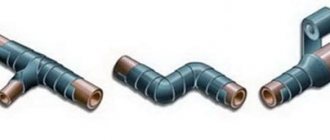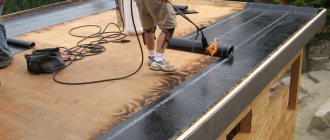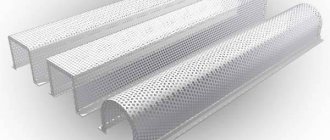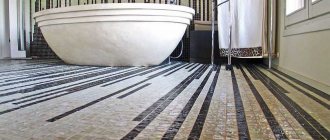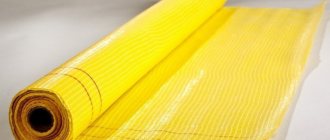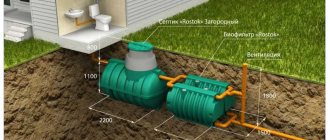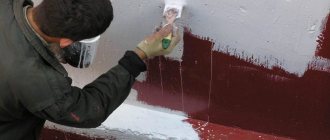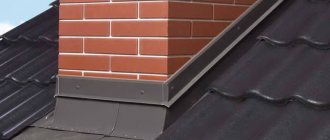Waterproofing pipes: review of popular moisture-proof materials
Waterproofing of pipelines is a necessary measure that is performed to protect the pipeline from moisture. Today, there are communications of different materials and purposes, and to increase their service life it is necessary to organize a suitable waterproofing material. The choice of waterproofing composite depends on many factors: pipe material, area of use, environmental characteristics, etc.
Waterproofing pipes and pipeline joints is a mandatory measure to protect networks from moisture
Thermal cameras and their applications
To protect important areas of the pipeline that are exposed to danger, such as joints and valves, expansion joints, bends, drainage devices and jumpers, a series thermal chamber is required. Its main purpose is to protect pipelines and the entire system from corrosion and environmental humidity.
The thermal chamber is a specialized in-depth structure made of heavy concrete, composed of the following products:
- an inverted glass with a hole at the top;
- rings in the middle;
- reinforced concrete glass below.
In the manufacture of products, concrete with special high-strength properties is used, which are given to it by special chemical additives.
The stability of the engineering system directly depends on the quality of the thermal chamber, its insulating properties, tightness and water resistance.
Types of waterproofing materials for pipes
To organize the waterproofing of various communications, many options for waterproofing are used. Let's look at the most popular of them:
- polyvinyl chloride (PVC) tape;
- heat shrink tape;
- rubber sheet;
- adhesive waterproofing Izol;
- polyurethane foam (PPU);
- heat-shrinkable couplings.
All of the above materials are distinguished by high technical characteristics, the main one of which is water resistance. Waterproofing of various pipes is necessary in order to protect the pipeline from the destructive effects of corrosion, as well as to extend the service life of the system as a whole.
Modern solution to the problem
The difficulty of repairing internal drainage arises from inaccessibility. But internal drainage pipes can be waterproofed using the sanitation method using FuranFlex Rainflex polymer stocking. Innovative technology allows you to restore the integrity of the entire system within just one day without dismantling the wall or other construction work.
The peculiarity of using FuranFlex polymer pipes for repairing internal drains is that they are highly flexible. This allows you to easily install them into a system of any configuration. The output is a single high-strength pipe, resistant to mechanical damage and aggressive substances, which completely prevents water from penetrating the walls and foundation.
Polyvinyl chloride (PVC) tape
Polyvinyl chloride (PVC) tape is very popular when organizing waterproofing of various communications. It has excellent characteristics and is mainly used to protect the outer surface of pipes from the harmful effects of corrosion.
Note! The most popular tape is made of polyvinyl chloride for protecting gas and oil pipelines, which are main lines.
PVC tape can be used to waterproof most pipes
In addition, nowadays polyvinyl chloride tape is used in the repair of heating pipelines, namely when replacing an old waterproofing insulation on communications transporting hot water or gas. In some cases, PVC tape is used for waterproofing utility lines.
One side of the PVC tape is supplied at the production stage with a special adhesive composition, which allows its installation to be carried out as conveniently as possible. Before using this tape, it is recommended to carefully check it for cracks and other defects.
This waterproofing is stored, transported and sold in special rolls that are wound on reels. To protect against moisture, such coils are wrapped in polyethylene.
Waterproofing materials
The outer surface of the bottom and walls of thermal chambers in the case of close groundwater, regardless of the built-in associated drainage, is supplemented with adhesive waterproofing made of bitumen roll material. The required number of layers of these materials is established by the project.
In cases where the requirements for water resistance are increased, in addition to the standard external lining waterproofing, additional plaster cement-sand internal waterproofing of thermal chambers is used. Such additional waterproofing is applied in large volumes using the shotcrete method.
For thermal cameras, a certain numbering is adopted, indicated on the communications plan in order to avoid blocking it during construction or laying roads.
Heating network failures can cause flooding of areas, soil deformation and building collapses. Such accidents are dangerous due to spills of hot water, so heating network chambers must be provided with access. Concrete plant Pride is a reliable partner that provides comprehensive turnkey supply of building materials. You can find a complete list of products on the page:
Heat shrinkable tape
This tape is used in cases where it is necessary to protect the welding joint. The location of the welding joint is the most vulnerable to the destructive effects of corrosion, so the use of heat-shrinkable waterproofing tape is a necessity. However, in some cases it is used to protect the surface of the entire communication, but such cases are extremely rare.
Heat-shrinkable tape is used to protect welded joints
It is important to remember that such tape is strictly prohibited from being used for installation on a pipeline if the operating temperature exceeds 60 °C. Heat-shrinkable tape provides reliable protection of welded joints and consists of two layers:
- hot melt layer;
- layer, which is a polyethylene film (PE film is the base).
In combination with this tape, you can also use a special fixing agent - a primer. In this case, such waterproofing is allowed to be used even for pipes that have a coating consisting of three layers.
Let's consider the main advantages of using heat-shrinkable waterproofing tape:
- high elasticity, allowing such tape to be mounted on a pipe with virtually no restrictions;
- the tape material is highly fire resistant;
- Heat shrink tape does not allow moisture to pass through.
Before installing such tape on a pipe, it is necessary to heat the pipe to a temperature of 80–100 °C. Today there are quite a few varieties of such tape and you can purchase it without much difficulty.
This tape has poor resistance to ultraviolet rays, so it must be stored in a dark place. Otherwise, it will lose its properties and will be useless. To waterproof one welded joint of a pipeline, you need an amount of tape equal to 3.5 times the pipe cross-section.
A preheated pipe is wrapped with polyethylene tape
Waterproofing of above-ground metal tanks
Above-ground metal containers are subject to aggression from atmospheric moisture and precipitation. The metal of such structures is practically not exposed to the risk of mechanical stress and does not experience mechanical pressure from flowing waters.
Therefore, the protection of such tanks is carried out using a different technology. For this purpose, the metal coating is treated with a primer based on bitumen with plastic additives in at least two layers and then painted over the dry primer with polyurethane paints.
Tank waterproofing
This technology makes it possible to create a high anti-corrosion barrier and ensure that the color of the tank coating is the required color - after all, color marking is often used to visually mark the contents.
If applied correctly and the technology is followed, the service life of the waterproofing layer of above-ground tanks is about 30 years, underground - about 35 years.
Izol adhesive waterproofing
The adhesive waterproofing material Izol is resistant to very high temperatures. In addition, this material is waterproof and has a high strength coefficient.
This material adheres well to the outer wall of the metal pipe and thereby provides high sealing performance. Due to its heat resistance, Izol is widely used as a waterproofing agent for steel pipes transporting hot water and steam.
However, it is worth noting that pipe waterproofing has poor resistance to aggressive chemicals, which consist of organic connectors and solvents . This material is classified into several main types depending on the components used in its production.
Adhesive waterproofing is stored, transported and sold in special rolls. In addition to waterproofing metal communications, this material is widely used for waterproofing bridges and other metal structures.
Let's consider the main advantages of Izol adhesive waterproofing:
- good adhesion to metal materials and concrete products;
- resistance to high temperatures (up to 150 °C);
- high strength characteristics;
- high waterproofing performance;
- long service life (up to 50 years).
A polyurethane foam shell can serve as both moisture protection and thermal insulation
How is internal drainage pipes waterproofed?
Waterproofing by rehabilitation using a polymer pipe is carried out in several main stages:
- Preparation. The interior drain is checked for blockages from leaves and other debris that could make it difficult to pull the pipe through the system. Also, specialists must make sure that there are no sharp protrusions in the pipes that could damage FuranFlex.
- Reaching out. From the top point on the roof, the polymer stocking is pulled through the entire system to the bottom point - the place where the water drains into the sewer or a special tank.
- Polymerization. The stocking is inflated with compressed air, and then inflated with hot steam. Under its action, the polymer resins harden, the pipe becomes hard and durable.
Shell made of polyurethane foam (PPU)
This waterproofing material is very popular due to its ease of installation. The polyurethane foam shell protects the pipe from corrosive influences, as well as from unwanted heat loss. Therefore, such material can be considered not only a waterproofing material, but also a heat insulator.
Note! It is worth noting that even pipes made of modern polymer materials need protection. This is due to the fact that condensate forms and accumulates on the surface of plastic pipes during operation, which leads to the development of fungus and mold in the main communications.
Thermal and waterproofing shell made of polyurethane foam eliminates the possibility of condensation on the surface of metal and plastic pipes. This insulator is efficient and reliable, and its installation does not require any special construction knowledge or skills.
Heat-shrinkable sleeves
First of all, it is worth noting that heat-shrinkable waterproofing couplings are put on the pipe before welding begins, and only after that they are “shrinked” at the site of the pipe weld.
Let's consider the positive aspects of using such a coupling:
- high levels of tightness;
- efficiency and reliability;
- resistance to aggressive chemicals;
- ease of installation;
- long service life.
Heat-shrinkable couplings are used to insulate the joints of pipes in heating and hot water systems.
The choice of the most suitable waterproofing material depends on specific conditions, so for each case it is necessary to select the most suitable waterproofing material. For insulation of welded seams in communications that transport hot water, the most suitable option is a waterproofing heat-shrinkable sleeve. Such a coupling is usually made from polyethylene.
Protecting metal in the ground
Hot and cold water supply pipelines, sewer pipes, heating pipelines, and ventilation system pipes must be protected from contact with water located in the ground. In industry, gas pipelines, oil pipelines, and underground tanks for storing various technical liquids are subject to waterproofing. Incorrect, sloppy insulation, performed in violation of standards, is fraught with emergency breakdowns due to leakage.
Waterproofing of metal structures in the ground
Protection with polyvinide chloride tape coating is used to isolate pipes from moisture , corrosion processes and mold fungi in the construction and use of pipelines for pumping petroleum products and natural gas. This coating is used when repairing problem areas of pipes, to correct joints and threaded pipes. Cover the surface of the pipeline in the ground when repairing heating main pipes.
Rubber sheets are used to wrap pipes to waterproof underground pipelines. Now they are used to insulate pipes in the basements of houses.
Canvas is a strong, elastic, neutral material, very durable. Easy to install, resistant to oils, acids, chemicals.
Izol is a type of adhesive insulation. Very durable material, resistant to critically high temperatures (over 130 degrees Celsius). It has proven itself very well in waterproofing heating systems. The material is very elastic, stretchable during installation. The disadvantage is that isol is easily affected by acids and other chemicals.
Adhesive waterproofing is easy to use due to its elasticity and creates an additional layer that strengthens the structure. Laminated waterproofing of metal pipelines can be used independently for insulating pipes in residential buildings.
Heat-shrinkable tape is a moisture insulator for welding joints of metal pipes and insulation of joints for plastic pipes. This is a two-component material consisting of a thermal melting layer and a layer of polyethylene film. When insulating the joints, they are wrapped with insulating thermal tape and heated. The thermal melting layer changes under the influence of heat and tightly grips the surface, sealing the joints.
Polymer self-adhesive tape is a material made of fluoroplastic and is used to protect threaded connections from leaks from moisture. Installation is carried out by winding into place with overlapping threads. Like all plastic materials, it can withstand heating to critical temperatures while maintaining its original characteristics.
Metal pipelines can be protected by coating with bitumen mastics. Bituminous waterproofing mastics are universal materials for waterproofing various surfaces. This is a two-component material consisting of bitumen and polymer additives to impart elasticity and strength. Now the industry is developing special types of mastics to protect metal pipelines exposed to extremely unfavorable conditions of use.
Protective materials also include waterproofing - a rolled waterproofing material made from asbestos film , which is treated with a two-component solution of bitumen with the addition of cellulose and polymer. Pipe structures are treated with a coating, which is further strengthened on the protected surfaces.
Rolled waterproofing coatings used for metal surfaces also include geotextiles. This polymer fabric does not decompose in the ground. It has excellent waterproofing properties, which makes working with it easy. Geotextiles do not weigh down hanging metal structures and are not susceptible to chemicals.
Features of chimney waterproofing
In addition to pipelines laid in the ground or in an open way, other pipes, for example, stove pipes, also need waterproofing. Roof pipe waterproofing is done using different materials. Let's look at them:
Bituminous insulating fabrics. Such a waterproofing material may include the following fabrics:
- cotton (cotton) fabric;
- jute fabric;
- asbestos fabric.
During the production process, any of the above fabrics is impregnated with a solution of soft bitumen. Then the top of such fabrics is treated with refractory bitumen.
Metalloizol . This material is represented by foil, which is treated with refractory bitumen during manufacturing.
Hydroisol. The production of such material involves treating a cardboard sheet with a bitumen mixture. This material is considered the most suitable for waterproofing roof pipes.
Important! Modern roofing consists of several layers that provide excellent waterproofing. These layers include insulation, waterproofing, and vapor barrier.
Borulin. This material is made from two materials: dried asbestos and molten bitumen. Borulin is used in non-standard conditions. For example, if the roof chimney is not installed correctly. Borulin is characterized by plasticity and high efficiency.
Source
Waterproofing of pipes with insulation
When laying water supply and sewerage pipes above the freezing depth, as well as for heating system pipes laid underground, their insulation is mandatory. Since all thermal insulation materials, without exception, lose their properties when wet, they must be additionally waterproofed.
Obviously, coating-type materials, as in the previous case, are not suitable here. In this case, the most often chosen method is to wrap pipes with waterproofing reinforced bitumen-based adhesive tapes, as well as polyvinyl chloride (PVC) wrapping adhesive tapes.
In each case, the pipe, pre-wrapped with insulation, is wrapped with tape with a large overlap and care is taken that the material lies flat without sagging. In addition, they control that the protective layer is quite strong and is not subsequently damaged by mechanical load from the soil.
Also on sale there are combined materials or so-called shells, which are a simultaneous combination of insulation with a waterproofing surface. The shell is selected to match the outer diameter of the pipeline. During installation, two parts of the shell are put on the pipe, fastened together using the grooves provided for this, and the joints are coated with sealant.
Waterproofing materials for pipes
You can find many types of waterproofing materials on sale. Each of them has its own advantages and disadvantages. Based on them, you will be able to make a choice in favor of one material or another.
Polyurethane foam
Among the main properties of the material are fire resistance and high strength. For waterproofing pipes, polyurethane foam is available in the form of shells or as part of the fill. Used to protect underground industrial pipelines, reinforced concrete sewer channels and heating mains. The material does an excellent job of sealing joints and protects the structure from corrosion. Read also: “Options for cathodic protection of pipelines - advantages and disadvantages of methods.”
PVC tape
The material is mainly used to improve the tightness of joints in external pipelines. Installation of polyvinyl chloride tape is possible only during construction or repair work. It is first necessary to check the pipeline for defects.
Polymer coatings
Folgoizol is elastic. The material includes two layers: foil and cardboard treated with a bitumen composition. It is used to protect heating mains, since it functions as a vapor barrier.
Hydroisol is called cardboard, which includes a layer of bitumen and asbestos. The material is often used due to its low cost and good quality, but it is flammable.
Brizol is produced in the form of rolls; mastic is used for its installation. The material is elastic.
Fiberglass is a durable waterproofing material characterized by a wide temperature range, high strength, elasticity and fire resistance. Available in roll form. Fiberglass is used for external insulation; when using it, additional cladding is required.
Heat shrink tape
Heat-shrinkable tape is used to insulate areas of pipeline joints. The material includes two layers and is applied using a “hot” connection. When the tape cools, a solid coating is obtained that reliably protects the structure from rusting. The material is most often used for waterproofing water supply pipes.
Liquid mastic for waterproofing pipes
This is a liquid composition with which it is convenient to isolate hard-to-reach areas of the highway. After it dries, a uniform protective layer is formed that prevents moisture from entering. Cured mastic has no joints. To apply it, you need a special device, as well as an air temperature above 0 o C.
The mastic is elastic, making it suitable for insulating structures with cracks. If the protective coating is destroyed, the area with defects is removed, and a new composition is poured in its place.
How to insulate a water pipe in the ground with your own hands
When choosing how to insulate a water pipe on a site, they take into account the material of its manufacture, the outer diameter, the cost of the insulation and the complexity of the installation work.
Rice. 11 Calculation of the thickness of the pipe heat insulator
Installation of insulation
Typically, low-pressure polyethylene pipes (HDPE) with a diameter of 1 inch are used to supply water for individual water supply; installation of the insulation shell is carried out in the following way:
- Install a shell made of glass wool, mineral wool or polystyrene foam, polyethylene foam, fixing it with adhesive tape. When installing mineral or glass wool, it is necessary to ensure the tightness of the joints - otherwise water will get into the joint and the wool will saturate it, and the thermal insulation properties of the insulation will be significantly reduced.
- After installation, the soft heat insulator can be protected from compression by the soil with a more durable material; usually they use roofing felt, wrapping it around the shell several times and securing it with tape. The advantage of its use is hydrophobicity, which protects the insulation from moisture absorption.
- The insulated pipeline is lowered into the channel and covered with a light granular composition to reduce pressure; expanded clay is usually used.
It should be taken into account that the installation of plastic segments must be carried out by fastening them to each other with a slight shift of 20 cm, like an overlap connection.
Fig. 12 Insulation of a plastic water pipe in the ground with a foam shell
Cabling
Installation of an electrical cable will cost more, but the depth of the pipeline is minimal. The heating wire can be located inside or outside the pipeline; water pipes are commercially available with an installed electrical cable or with a cable channel for its installation. Most often, cable installation is used on the surface, while the depth of the pipeline does not exceed 50 cm. Installation of a cable heater consists of the following stages:
- The pipeline at the location of the cable (in a spiral or straight line) is covered with foil adhesive tape.
- The electrical cable is laid on the glued tape and secured with the same adhesive tape.
- A shell of basalt insulation is installed on top of the resulting structure, which is connected with tape. When installing a heating cable along a line, it is practical to use foam insulation with special grooves.
- To monitor the operation of the system, it is advisable to install temperature sensors along the water supply line.
Rice. 13 How to insulate a water pipe underground with an electrical cable
When deciding how best to insulate a water pipe in the ground with your own hands, many people prefer a foam shell - it is easy to install, has better physical parameters and is low in cost. It is more practical to use an electric cable when the water pipes and well head are shallow - it can be used to simultaneously heat the water in the main and the well.
Roof chimney insulation
The chimney in a private house exits through a hole in the roof. It requires careful protection. Let's figure out how to waterproof a pipe on a roof. The gaps are sealed with waterproof sealant, but installation of a drainage system and special elements: “apron” and “tie” are also required.
Sealing of the structure is carried out in several stages. First you need to prime the pipe and treat it with bitumen-based mastic. You need to connect a diffuse membrane to it. Now you can move on to making a wooden box. It is installed between the pipe and the roof (more details: “How and with what to seal the gap between the pipe and the roof - different options for different materials”). In this case, the gap should be at least 15 cm. All free niches are filled with non-flammable material, for example, mineral wool.
The main methods of insulating an underground water main
There are several methods of insulating water pipes, which have different principles of operation, some of them are used only in the industrial sector.
Use of insulation materials
The use of building materials with a low thermal conductivity coefficient is one of the simplest methods, which is the most common for insulating pipes in the ground and on the surface. Materials may be placed around the pipes or applied to their surface in the form of paint, resin or foam. The technology is widely used in the industrial sector, for insulating water supply and sewerage systems in private homes.
Heating cable
An electric heating cable is placed inside or close to the pipe and heats it, preventing the water from freezing. The cables themselves are sold in specialized stores, their power ranges from 10 to 20 watts per linear meter; the use of a cable system allows you to bury the water supply at a distance of no more than 50 cm from the surface of the earth.
The advantages of using a cable are the ability to be placed directly in the water, this allows it to be mounted inside a pipeline and lowered into a well to a considerable depth. The use of an electric cable inside the pipes simultaneously with the installation of external insulation is the most effective and economical solution for protecting the water main from freezing during individual water supply.
Rice. 3 Thermal conductivity of various materials
Air insulation
A more expensive method that is used in industrial and public utilities. When it is used underground, the pipeline is insulated from above using insulation, and warm air is supplied from below, warming the water supply.
A method often used is when the pipeline is placed in a large diameter pipe, inside which warm air passes. This method is usually used to insulate a water main running along the surface; it can also be used in individual areas if the pipeline is buried in the ground - the air gap will prevent the water from freezing without heating.
Pressure insulation
Using pressure, water supply systems are protected from freezing in underground main systems or in unheated rooms; a special receiver is used to increase the pressure. The pressure in the system with this method exceeds 5 atmospheres, while standard pumping equipment for organizing individual water supply is designed to operate with a pressure of no more than 3 bar.
Rice. 4 Electric heating cable - appearance
This technique was developed for use in industrial and municipal engineering communication systems; in everyday life, the use of high pressure is effective if there is a high-quality pipeline and devices designed to work with high pressure. To implement the method, it is necessary to pump water into the main line using an electric pump under a pressure of more than 5 bar. and turn off the pumping equipment - theoretically, water at this pressure should not freeze for a very long time in the absence of the owners.
